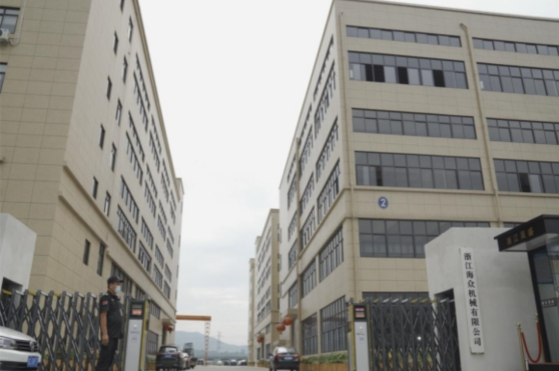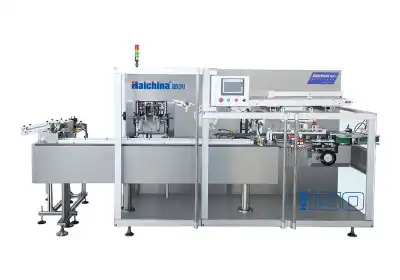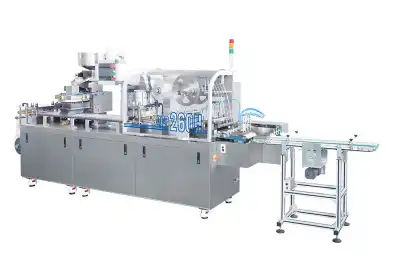Blister Packaging Machine or Thermoforming Machine
When it comes to packaging solutions for pharmaceuticals, cosmetics, commodities, and foodstuffs, blister packaging machines and thermoforming machines are two popular options. Both technologies offer unique advantages, but understanding their differences is crucial for making an informed decision. Blister packaging machines are specifically designed for creating individual, sealed compartments for products, typically using a combination of plastic and aluminum foil. On the other hand, thermoforming machines heat plastic sheets and mold them into desired shapes, offering versatility in packaging design. The choice between these two depends on factors such as product type, production volume, and specific industry requirements. In this article, we'll delve deeper into both technologies to help you determine which one best suits your packaging needs.

Understanding Blister Packaging Machines
The Fundamentals of Blister Packaging
Blister packaging is a widely used packaging method designed to encase individual products in a transparent plastic cavity that is pre-formed using heat and pressure. This cavity is typically sealed with a backing material such as aluminum foil or paperboard, ensuring a secure and tamper-evident closure. Common in pharmaceuticals, small electronics, and retail goods, blister packaging enhances product presentation while maintaining hygiene and integrity. Its structure allows consumers to view the product clearly without opening the package.

Components of a Blister Packaging Machine
A blister packaging machine integrates several key functional stations that operate in a coordinated manner. First, the forming station uses heat and pressure to shape thermoplastic sheets into cavities tailored to specific product dimensions. Next, the loading station introduces products into the formed blisters, either through automated systems or manual placement. The sealing station then applies precise heat and pressure to adhere the backing material, securing the product. Finally, the cutting station trims and separates individual blister packs for final packaging.

Advantages of Using Blister Packaging Machines
Blister packaging machines offer a host of operational and protective benefits. Their automated processes enhance production efficiency, allowing manufacturers to package large quantities of products with minimal manual labor. The clear plastic casing promotes product visibility, which is crucial for retail presentation. Furthermore, the sealed nature of blister packs shields items from dust, moisture, and tampering, ensuring product safety and quality. These features make blister packaging machines an ideal solution for industries that prioritize hygiene, security, and high-volume output.

Exploring Thermoforming Machines
The Thermoforming Process Explained
Thermoforming is a widely adopted manufacturing process that involves heating a flat plastic sheet until it becomes pliable, then forming it into a specific shape using a mold. Once the material cools and hardens, it is trimmed to produce the final product. This method is highly adaptable and suitable for creating everything from disposable trays and clamshell packaging to intricate, multi-compartment containers. Its simplicity, speed, and ability to handle a variety of shapes make thermoforming, including in blister packaging machines, ideal for both industrial and consumer packaging solutions.
Types of Thermoforming Machines
Thermoforming machines come in two primary varieties: vacuum forming and pressure forming. Vacuum forming relies on negative air pressure to draw the heated plastic over the mold surface, making it suitable for basic shapes and shallow depths. Pressure forming, on the other hand, uses compressed air to force the plastic into the mold, resulting in sharper details and more precise finishes. Some modern machines, including certain types of blister packaging machines, combine both techniques, offering flexibility in design complexity, surface detailing, and production needs across a wide range of packaging applications.
Applications and Benefits of Thermoforming
Thermoforming machines are integral to industries such as food packaging, healthcare, electronics, and retail. Their ability to shape plastic into tailored forms allows companies to create protective, visually appealing, and brand-specific packaging. This process accommodates both small batches and mass production, making it a cost-effective solution regardless of scale. Thermoforming also supports the use of recyclable and lightweight materials, which contributes to sustainable packaging practices. The result is a fast, flexible, and efficient packaging method that meets diverse industrial and consumer demands.
Comparing Blister Packaging and Thermoforming Technologies
Production Efficiency and Speed
Blister packaging machines are specifically engineered for high-speed, continuous production, often reaching outputs of several thousand units per hour. This makes them highly effective for industries like pharmaceuticals, where uniformity and rapid throughput are critical. Thermoforming machines also offer high production speeds, but they excel in applications requiring custom shapes or varied packaging sizes. Their flexibility makes them suitable for smaller or mixed production runs. While not always as fast as blister machines, thermoformers are valued for their adaptability in diverse manufacturing environments.
Material Compatibility and Sustainability
Thermoforming machines are compatible with a broad range of plastic materials, including biodegradable and recycled options, giving manufacturers greater flexibility to meet environmental goals. This adaptability makes thermoforming attractive for companies prioritizing sustainability and custom material selection. Blister packaging traditionally relied on PVC and similar materials, but modern machines now support newer, more sustainable films such as PET or PLA. Although slightly more limited in material range, blister packaging technology is evolving to align with global sustainability trends and eco-conscious consumer demands.
Cost Considerations and ROI
Blister packaging machines, particularly those designed for automated, large-scale operations, often involve a higher upfront investment. However, their high output and minimal downtime contribute to faster returns for companies with stable, high-volume product lines. Thermoforming machines typically cost less initially and offer versatility in production, making them suitable for businesses with varied product dimensions or short-run projects. That said, frequent tooling changes in thermoforming can add to long-term operational costs. The optimal choice depends on production consistency, customization requirements, and long-term cost-efficiency goals.
Conclusion
Choosing between a blister packaging machine and a thermoforming machine depends on various factors including product type, production volume, and specific industry requirements. Blister packaging machines excel in high-speed, standardized production, offering excellent product visibility and protection. Thermoforming machines provide greater flexibility in design and material choice, making them suitable for diverse packaging needs. Both technologies continue to evolve, offering improved efficiency and sustainability options. Ultimately, the decision should align with your company's long-term packaging strategy and production goals.
Contact Us
For more information about our blister packaging and thermoforming solutions, or to discuss which option might be best for your specific needs, please don't hesitate to contact us at [email protected]. Our team of experts at Zhejiang Haizhong Machinery Co., Ltd. is ready to assist you in finding the perfect packaging solution for your business.
References
Johnson, M. (2022). Advances in Blister Packaging Technology. Journal of Pharmaceutical Packaging, 45(2), 78-92.
Smith, A. & Brown, T. (2021). Thermoforming: A Comprehensive Guide to Modern Packaging Solutions. Industrial Packaging Review, 33(4), 112-128.
Zhang, L. et al. (2023). Comparative Analysis of Blister Packaging and Thermoforming in the Pharmaceutical Industry. International Journal of Packaging Technology, 18(3), 201-215.
Wilson, R. (2022). Sustainability in Packaging: Innovations in Blister and Thermoform Technologies. Green Packaging Quarterly, 7(2), 45-59.
Davis, E. & Taylor, S. (2021). Cost-Benefit Analysis of Modern Packaging Equipment: A Case Study. Journal of Industrial Engineering, 29(1), 88-102.
Patel, N. (2023). The Future of Packaging: Integrating Smart Technologies in Blister and Thermoform Machines. Tech in Manufacturing, 12(4), 156-170.

Submit the form now to get a unique quote!

ZHEJIANG HAIZHONG MACHINERY CO., LTD.
Popular Blogs
-
 Successful caseProducts and services
Successful caseProducts and servicesHow to Train Employees to Operate a Bottle Packing Machine Effectively?
-
 Successful caseIndustry insights
Successful caseIndustry insightsThe Blister Packaging Process: A Complete Step-by-Step Guide
-
 Successful caseComparative analysisIndustry insights
Successful caseComparative analysisIndustry insightsWhat Type of PVC Is Best for Blister Packing Machines?